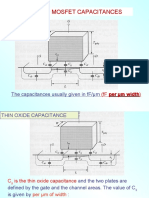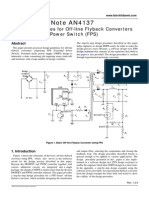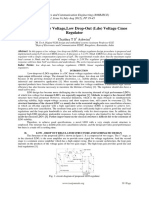Lect12 Inverter
Lect12 Inverter
Uploaded by
Vimala PriyaCopyright:
Available Formats
Lect12 Inverter
Lect12 Inverter
Uploaded by
Vimala PriyaOriginal Description:
Original Title
Copyright
Available Formats
Share this document
Did you find this document useful?
Is this content inappropriate?
Copyright:
Available Formats
Lect12 Inverter
Lect12 Inverter
Uploaded by
Vimala PriyaCopyright:
Available Formats
Advanced VLSI Design
CMOS Inverter
CMPE 640
The Inverter The electrical behavior of complex circuits (adders, multipliers) can be almost completely derived by extrapolating the results obtained for inverters!
VGS < Vt Vin Vout CL Modeled Ron
Vout VGS > Vt
Ron
Vout
Observations Fully restored (VDD and GND) output levels results in high noise margins. Ratioless: Logic levels are not dependent on the relative device sizes. Low output impedance in steady state (kW connection to either VDD or GND), increases robustness to noise. High input impedance: fanout is theoretically unlimited for static operation, transient response is impacted however. Low static power dissipation: No path between power and ground.
1
Advanced VLSI Design
CMOS Inverter
2.5V 2.0V 1.5V
CMPE 640
The Inverter DC current characteristics
0V 0.5V
IDS (mA)
Load-line plot Here, PMOS curves have been mirrored around x and shifted. The current of the NMOS and PMOS device MUST be equal. All points are located at either the 0V high or low output levels. NMOS sat PMOS lin NMOS sat PMOS sat NMOS lin PMOS sat NMOS lin PMOS off
1V 1.5V 2.0V
1V 0.5V
2.5V
NMOS off VDD PMOS lin Vout 1.25V
Inverter exhibits a very narrow transition zone.
0V
Vin
1.25V
VDD
2
Advanced VLSI Design
CMOS Inverter
CMPE 640
Inverter Models It is possible to approximate the transient response to an RC model. The response is dominated by the output capacitance of the gate, CL. Rp
Vout Rn CL
Vout CL
Load capacitance, CL, is due to diffusion, routing and downstream gates. The propagation delay assuming an instantaneous input transition is RpCL. This indicates a fast gate is built by keeping either or both of Rp and CL small. Rp is reduced by increasing the W/L ratio. Bear in mind that, in reality, Rn/p is a nonlinear function of the voltage across the transistor.
Advanced VLSI Design
CMOS Inverter
CMPE 640
Switching Threshold Previously, we defined VM as the inverter threshold voltage but did not derive an analytical expression for it. The same is true for VIH and VIL, and consequently the noise margins (see text for this analysis). VM is defined as the intersection of the line Vin = Vout and the inverter VTC. VTC Vin=Vout
Vout
VM (gate threshold voltage)
Vin In this region, both the NMOS and PMOS transistors are in saturation since VDS = VGS.
4
Advanced VLSI Design
CMOS Inverter
CMPE 640
Switching Threshold Therefore, the value of VM can be obtained by equating the NMOS and PMOS currents (assuming devices are velocity saturated). V V V DSATn + k V V V V V DSATp -----------------------------------k n V DSATn M Tn p DSATp M DD Tp 2 2 Solving for VM: VM
2
V DSATn V DSATp r V Tn ------------------- + r V DD + V Tp + ------------------ 2 2 = --------------------------------------------------------------------------------------------------------------1+r k p V DSATp satp W p r = ------------------------- = -------------------k n V DSATn satn W n
Further simplified: rV DD ------------VM 1+r
with
VM is set by the ratio r, and r compares the relative driving strengths of the PMOS and NMOS transistors. It is desirable to have r = 1, i.e., VM situated in the middle of the available voltage swing (VDD/2) to provide comparable low and high noise margins.
5
Advanced VLSI Design
CMOS Inverter
CMPE 640
Switching Threshold The required ratio can be determined for any value of VM using: V V V DSATn ------------------V DSATn k n M Tn ( W L )p 2 ------------------- = ---------------------------------------------------------------------------------------------------( W L )n V DSATp V DSATp k p V DD V M + V Tp + ------------------ 2 Using a generic 0.25 mm CMOS process, this means making the PMOS 3.5 times wider than the NMOS. VM plotted as a function of the PMOS-to-NMOS ratio. 2.0 VM (V) 1.6 1.2 0.8 0.1 x scale gives the log of the ratio of PMOS and NMOS widths as the difference.
6
1.0
Wp-Wn
10.0
Advanced VLSI Design
CMOS Inverter
CMPE 640
Switching Threshold Observations from plot VM is relatively insensitive to variations in device ratio. Small variations in the ratio (3.0 -> 2.5) do not disturb the VTC much. Industry sets the ratio of PMOS width to NMOS width to values smaller than that needed for an exact symmetry. For example, setting the ratio to 3, 2.5 and 2 yields switching thresholds of 1.22 V, 1.18 V and 1.13 V, respectively. Increasing the width of the PMOS or the NMOS moves VM toward VDD or GND, respectively. This feature may be desirable in some applications, e.g., when the input signal is noisy (see text). Bear in mind that when the ratio of VDD to VT is relatively small, e.g. 2.5/0.4 = 6), moving VM a lot is difficult and requires very large differences in the width ratios.
7
Advanced VLSI Design
CMOS Inverter
CMPE 640
Inverter Threshold Robustness under process variations:
VDD
Weak NMOS Strong PMOS
1.25V
Strong NMOS Weak PMOS
Vout Vin
1.25V
Nominal
VDD
Process variations will cause only small shifts in the transfer curve. The functionality of the gate is not effected however, and this feature has contributed in a big way to the popularity of the static CMOS gate.
Advanced VLSI Design
CMOS Inverter
CMPE 640
Dynamic Behavior Propagation delay is determined by the time it takes to charge/discharge the load cap, CL, so it's worth looking closely at CL before developing a delay model. Simple propagation delay models lumps all capacitances into CL. M2 Vin Cgd12 Cdb2 Cdb1 M1 Cw
Vout
Cg4 Cg3
M4 Vout2 M3
All cap influencing transient response of node Vout.
In this analysis, assume Vin is driven by an ideal voltage source with fixed rise/fall times.
Advanced VLSI Design
CMOS Inverter
CMPE 640
Dynamic Behavior Gate-drain capacitance Cgd12: Capacitance between the gate and drain of the first inverter. M1 and M2 are either in cut-off or in saturation during the first half (up to 50% point) of the output transient. It is reasonable to assume that only M1 & M2 overlap capacitances contribute. Remember, gate cap is either completely between gate/bulk (cut-off) or gate/src (sat). In the lumped model, we need to replace the Cgd12 with a capacitor to GND. The value of this capacitor is given as Cgd = 2*CGD0*W where CGD0 is overlap capacitance per unit width. Note it is doubled due to the Miller effect.
10
Advanced VLSI Design
CMOS Inverter
CMPE 640
Dynamic Behavior Diffusion capacitances Cdb1 and Cdb2: Capacitances due to the reversed biased pn-junction. These caps are quite nonlinear (voltage dependent). We linearized these caps over the voltage range of interest: C eq = K eq C j0 with Cj0 the junction cap/unit area under zero bias conditions. The bottom plate and sidewall zero bias values can be obtained from the SPICE model CJ and CJSW parameters. Keq was derived in an earlier lecture. K eq = ------------------------------------------------------ ( 0 V high ) ( V high V low ) ( 1 m )
1m
( 0 V low )
1m
11
Advanced VLSI Design
CMOS Inverter
CMPE 640
Example Consider a 0.25 mm 2.5 V technology and the previous inverter chain. Assume f0 is 0.9 V for both NMOS and PMOS and m = 0.5. Let's compute Cdb1 for the NMOS transistor. Propagation delay is computed between the 50% points. This is the time-instance when Vout reaches 1.25 V. For the high-to-low (H-to-L) transition, we linearize over {2.5 V, 1.25 V} and for the low-to-high transition over {0, 1.25 V}. H-to-L: Vout is initially 2.5 V: Vhigh = -2.5V. At 50%, Vlow = -1.25V. Keq= 0.57. L-to-H: Vout is initially 0 V: Vlow = 0. At 50%, Vhigh = -1.25 V. Keq = 0.79. Sidewall capacitance can be computed in a similar way (see text). Also, similar, but reversed, values are obtained for PMOS device. This linearized simplification has only minor effects on logic delays.
12
Advanced VLSI Design
CMOS Inverter
CMPE 640
Dynamic Behavior Wire capacitance Cw: The capacitance is dependent on the length and width of the interconnecting wires and is growing in importance. Gate capacitance of fan-out Cg3 and Cg4: Includes both overlap and gate capacitance of each transistor: C
fan out
= C gate ( NMOS ) + C gate ( PMOS ) = ( C GSOn + C GDOn + W n L n C ox ) + ( C GSOp + C GDOp + W p L p C ox )
But what about the Miller effect? We can safely ignore it here by assuming the driven gate's output does not change until after the 50% point of the input is reached. We also assume, with about a 10% over-estimation error, that the channel cap of the driven gate remains constant over this interval.
13
Advanced VLSI Design
CMOS Inverter
CMPE 640
Dynamic Behavior Text gives the capacitance calculated from the layout of a two-inverter chain. Results are given as follows: Overlap capacitance: NMOS: 0.31 fF/m PMOS: 0.27 fF/m Bottom junction capacitance: NMOS: 2.0 fF/m2 PMOS: 1.9 fF/m2 Sidewall junction capacitance: NMOS: 0.28 fF/m PMOS: 0.22 fF/m Gate capacitance: NMOS = PMOS: 6.0 fF/m2 Wire capacitance: Cwire: 0.12 fF Total load for H-to-L: 6.1 fF, for L-to-H: 6.0 fF In text, this cap is almost evenly split between intrinsic and extrinsic srcs.
14
Advanced VLSI Design
CMOS Inverter
CMPE 640
Propagation Delay: First-Order Analysis One way to compute delay is to integrate the capacitor (dis)charge current: CL ( v ) t p = -------------- dv i(v)
v1 v2
But both CL(v) and i(v) are nonlinear functions of v. Instead, we can use a simple switch model given earlier to derive an approximation. Here, both the "on" resistance and load capacitance are replaced by a constant elements, assigned average values over the region of interest. Although we didn't cover it in class, the average "on" resistance is given by: R eq 1 = ----------------V DD 2 with
V DD
V DD 2
V DD 3 -------------- V ------------------------------------- dV -- 1 7 V DD 4 I DSAT I DSAT ( 1 + V ) 9
2
I DSAT
V DSAT W ---- ( V DD V T )V DSAT ---------------- = k 2 L
(see text)
15
Advanced VLSI Design
CMOS Inverter
CMPE 640
Propagation Delay: First-Order Analysis The linearized load capacitance is derived as shown previously. Propagation delay is then computed using a first-order linear RC network model: t pHL = ln ( 2 ) R eqn C L = 0.69R eqn C L t pLH = ln ( 2 ) R eqp C L = 0.69R eqp C L Assuming that the equivalent load cap is approximately the same for either transition. The propagation delay is the average of the two: R eqn + R eqp t pHL + t pLH t p = ---------------------------- = 0.69C L ---------------------------- 2 2 This indicates to make rise and fall times identical, it is necessary to make the "on" resistance of the NMOS and PMOS equal. See text for a good example.
16
Advanced VLSI Design
CMOS Inverter
CMPE 640
Propagation Delay: First-Order Analysis Minimizing propagation delay amounts to: Reducing CL. Which is composed of self-loading (diffusion) (intrinsic), routing and fan-out (extrinsic) capacitance. Careful layout can reduce diffusion and interconnect caps. Increase W/L ratio of the transistors. Warning: doing so increases the self-loading and therefore CL! Once intrinsic (self-loading) cap starts to dominate the extrinsic load cap (wires + fanout), increasing the width doesn't help delay. Increase VDD. The delay of a gate can be modulated by modifying the supply voltage. This allows the designer to trade off energy dissipation for performance. However, rising above a certain level yields on a minor improvement. Also, reliability concerns (oxide breakdown, hot-electron effects) set firm upper bounds.
17
You might also like
- Automated Broad and Narrow Band Impedance Matching for RF and Microwave CircuitsFrom EverandAutomated Broad and Narrow Band Impedance Matching for RF and Microwave CircuitsNo ratings yet
- Microelectronics Lab ReportsDocument75 pagesMicroelectronics Lab ReportsAmArbir SinghNo ratings yet
- CMOS Inverter Modelling On CADENCEDocument5 pagesCMOS Inverter Modelling On CADENCESanket KoleyNo ratings yet
- OlxDocument23 pagesOlxPoonam Dimple Ruchwani0% (1)
- Pass Gate Logic: Switch NetworkDocument34 pagesPass Gate Logic: Switch NetworkSunil SharmaNo ratings yet
- Ratioed Logic: R Resistive Load V 0 Depletion Load V 0 Pmos LoadDocument13 pagesRatioed Logic: R Resistive Load V 0 Depletion Load V 0 Pmos LoadAmjad WadalaNo ratings yet
- Pn-Junction: Excess Minority Carrier Charge Space ChargeDocument28 pagesPn-Junction: Excess Minority Carrier Charge Space ChargePrashant Kumar SinghNo ratings yet
- Iscas06 Curr RefDocument4 pagesIscas06 Curr Refkareka_ccNo ratings yet
- Chap16 2 CMOS Inverter ModifiedDocument14 pagesChap16 2 CMOS Inverter ModifiedSai Kiran OrugantiNo ratings yet
- CMOS SubcircuitsDocument80 pagesCMOS SubcircuitsashishmanyanNo ratings yet
- Topic 5 - Cmos InverterDocument34 pagesTopic 5 - Cmos InverterjebonNo ratings yet
- Cmos InverterDocument32 pagesCmos InverterSatish BojjawarNo ratings yet
- Cmos BooksDocument10 pagesCmos BooksMuthiah RajaNo ratings yet
- VM Switching PowerDocument81 pagesVM Switching PowerSuman MalikNo ratings yet
- Combinational Mos Logic Circuits: Basic ConceptsDocument41 pagesCombinational Mos Logic Circuits: Basic Conceptsflampard24No ratings yet
- Unit 5Document6 pagesUnit 5Tarun SinghalNo ratings yet
- Model 1Document22 pagesModel 1Vinay MLNo ratings yet
- Characterization of A Generic 90nm CMOS Technology: DS DS DS GSDocument10 pagesCharacterization of A Generic 90nm CMOS Technology: DS DS DS GSgill6335No ratings yet
- Level ShifterDocument4 pagesLevel ShifterPriyankar MathuriaNo ratings yet
- Review of Mosfet Capacitances: The Capacitances Usually Given in FF/ MDocument46 pagesReview of Mosfet Capacitances: The Capacitances Usually Given in FF/ MSalim SanNo ratings yet
- Low Power VLSI Unit 2Document14 pagesLow Power VLSI Unit 2JAI ROYALNo ratings yet
- Basic MOS Device Physics: Zou Zhige 2007 HUSTDocument62 pagesBasic MOS Device Physics: Zou Zhige 2007 HUSTSHIVA VERMANo ratings yet
- ECE124A F11 HW5 SolutionsDocument4 pagesECE124A F11 HW5 SolutionsPeter VerlangieriNo ratings yet
- 1995 IscasDocument4 pages1995 IscasfrostyfoleyNo ratings yet
- Fly BackDocument20 pagesFly BackĐặng Văn TàiNo ratings yet
- Unit 4 - 2Document49 pagesUnit 4 - 2sparsh kaudinyaNo ratings yet
- Lec03 AE MS14Document43 pagesLec03 AE MS14Mohsin Abbas ZafarNo ratings yet
- Voltage Controlled Oscillators v1 (March 22)Document37 pagesVoltage Controlled Oscillators v1 (March 22)소공자No ratings yet
- MOSFET at DC + Small SignalDocument59 pagesMOSFET at DC + Small SignalSamarth MinochaNo ratings yet
- Revisit: Resistance and Capacitance MOSFET Model For Digital CircuitsDocument33 pagesRevisit: Resistance and Capacitance MOSFET Model For Digital Circuitsdilshan singhNo ratings yet
- Vlsi Classroom Material (16-Aug-2011)Document37 pagesVlsi Classroom Material (16-Aug-2011)naveensilveriNo ratings yet
- CMOS InverterDocument15 pagesCMOS Inverterمصطفى عادل أصغر حسن العبيديNo ratings yet
- Bicmos Logic GatesDocument25 pagesBicmos Logic GatesRavi Chandra KumarNo ratings yet
- A Multi-Loop Low-Dropout FVF Voltage Regulator With Enhanced Load RegulationDocument4 pagesA Multi-Loop Low-Dropout FVF Voltage Regulator With Enhanced Load RegulationAram ShishmanyanNo ratings yet
- An-978 HV Floating MOS Gate DriversDocument21 pagesAn-978 HV Floating MOS Gate DriversPeter RueNo ratings yet
- Design of A Low Voltage, Low Drop-Out (Ldo) Voltage Cmos RegulatorDocument7 pagesDesign of A Low Voltage, Low Drop-Out (Ldo) Voltage Cmos RegulatorSavio SNo ratings yet
- Lab 9 XDocument11 pagesLab 9 XNandita GuptaNo ratings yet
- Application Note AN-4150: Design Guidelines For Flyback Converters Using FSQ-series Fairchild Power Switch (FPS™)Document16 pagesApplication Note AN-4150: Design Guidelines For Flyback Converters Using FSQ-series Fairchild Power Switch (FPS™)Nagendra ChaitanyaNo ratings yet
- Aic Lab Cadence 11 Folded v02Document9 pagesAic Lab Cadence 11 Folded v02Hagar IlbheryNo ratings yet
- AN10009 Differential Terminations Rev1.2Document18 pagesAN10009 Differential Terminations Rev1.2eppramod3271No ratings yet
- Lecture 4-Shunt CompensationDocument44 pagesLecture 4-Shunt CompensationSidharth MishraNo ratings yet
- UNIT 3: Transistor Sizing in CMOS: Aims and ObjectivesDocument12 pagesUNIT 3: Transistor Sizing in CMOS: Aims and ObjectivesGirish Kv50% (2)
- Cmos InvDocument25 pagesCmos InvkumarbsnspNo ratings yet
- An 4137Document20 pagesAn 4137Andres RinconNo ratings yet
- Low Power MuxDocument4 pagesLow Power MuxPromit MandalNo ratings yet
- Cad Lab ManualDocument15 pagesCad Lab ManualSougata Ghosh100% (2)
- Vlsi l4 Static Cmos InvDocument26 pagesVlsi l4 Static Cmos InvSuriya SkariahNo ratings yet
- Float DriveDocument24 pagesFloat DriveEdy AchalmaNo ratings yet
- EEE 5321 Sp24 HW1 Ver2 020524Document4 pagesEEE 5321 Sp24 HW1 Ver2 020524Towsif Muhtadi KhanNo ratings yet
- Unit 4 - 2Document49 pagesUnit 4 - 2sparsh kaudinyaNo ratings yet
- Lecture 8 B NewDocument45 pagesLecture 8 B NewMostafa MohamedNo ratings yet
- Low-Voltage CMOS Analog Bootstrapped Switch For Sample-and-Hold Circuit: Design and Chip CharacterizationDocument4 pagesLow-Voltage CMOS Analog Bootstrapped Switch For Sample-and-Hold Circuit: Design and Chip CharacterizationwhamcNo ratings yet
- A 93.7% Peak Efficiency DC-DC Buck Converter With All-Pass Network Based Passive Level Shifter in 55 NM CMOSDocument4 pagesA 93.7% Peak Efficiency DC-DC Buck Converter With All-Pass Network Based Passive Level Shifter in 55 NM CMOSRaghvendra DeshpandeNo ratings yet
- 1 - Design CMOS Digital Level Shifter, Abhijit AsatiDocument3 pages1 - Design CMOS Digital Level Shifter, Abhijit Asatibhavin_patel_20988No ratings yet
- Vlsi Lab1 F 13 v3 SentDocument27 pagesVlsi Lab1 F 13 v3 SentAnonymous 0yEAbwuNo ratings yet
- Reference Guide To Useful Electronic Circuits And Circuit Design Techniques - Part 2From EverandReference Guide To Useful Electronic Circuits And Circuit Design Techniques - Part 2No ratings yet
- Highly Integrated Gate Drivers for Si and GaN Power TransistorsFrom EverandHighly Integrated Gate Drivers for Si and GaN Power TransistorsNo ratings yet
- Reference Guide To Useful Electronic Circuits And Circuit Design Techniques - Part 1From EverandReference Guide To Useful Electronic Circuits And Circuit Design Techniques - Part 1Rating: 2.5 out of 5 stars2.5/5 (3)
- Lecture 4 - The CMOS InverterDocument7 pagesLecture 4 - The CMOS InverterVimala PriyaNo ratings yet
- The Design of A High-Performance Full Adder Cell by Combining Common Digital Gates and Majority FunctionDocument13 pagesThe Design of A High-Performance Full Adder Cell by Combining Common Digital Gates and Majority FunctionVimala PriyaNo ratings yet
- An Implementation of A FIR Filter On A GPU: Alexey Smirnov and Tzi-Cker ChiuehDocument8 pagesAn Implementation of A FIR Filter On A GPU: Alexey Smirnov and Tzi-Cker ChiuehVimala PriyaNo ratings yet
- Formulari Sessio1 EngDocument2 pagesFormulari Sessio1 EngVimala PriyaNo ratings yet
- Efficient Polyphase DecompositionDocument4 pagesEfficient Polyphase DecompositionVimala PriyaNo ratings yet
- DSPDocument116 pagesDSPShreyas EsheNo ratings yet
- Implementation of Text Based Cryptosystem Using Elliptic Curve CryptographyDocument4 pagesImplementation of Text Based Cryptosystem Using Elliptic Curve CryptographyVimala PriyaNo ratings yet
- CmosvlsiDocument50 pagesCmosvlsiprvnkdvdNo ratings yet
- Prediction and Comparison of High-Performance On-Chip Global InterconnectionDocument13 pagesPrediction and Comparison of High-Performance On-Chip Global InterconnectionVimala PriyaNo ratings yet
- A Novel Design of CAVLC Decoder With Low Power and High Throughput ConsiderationsDocument9 pagesA Novel Design of CAVLC Decoder With Low Power and High Throughput ConsiderationsVimala PriyaNo ratings yet
- A High-Throughput LDPC Decoder Architecture With Rate CompatibilityDocument9 pagesA High-Throughput LDPC Decoder Architecture With Rate CompatibilityVimala PriyaNo ratings yet
- A Low-Power FPGA Based On Autonomous Fine-Grain Power GatingDocument13 pagesA Low-Power FPGA Based On Autonomous Fine-Grain Power GatingVimala PriyaNo ratings yet
- Automated Design Debugging With Maximum SatisfiabilityDocument14 pagesAutomated Design Debugging With Maximum SatisfiabilityVimala PriyaNo ratings yet
- Leakage Power and Circuit Aging Cooptimization by Gate Replacement TechniquesDocument14 pagesLeakage Power and Circuit Aging Cooptimization by Gate Replacement TechniquesVimala PriyaNo ratings yet
- Crypto 1Document12 pagesCrypto 1Vimala PriyaNo ratings yet
- An Efficient Multimode Multiplier Supporting AES and Fundamental Operations of Public-Key CryptosystemsDocument11 pagesAn Efficient Multimode Multiplier Supporting AES and Fundamental Operations of Public-Key CryptosystemsVimala PriyaNo ratings yet
- Exploring The Potential of Threshold Logic For Cryptography-Related OperationsDocument11 pagesExploring The Potential of Threshold Logic For Cryptography-Related OperationsVimala PriyaNo ratings yet
- Cluster 2Document11 pagesCluster 2Vimala PriyaNo ratings yet
- Redhat For SAP HANADocument51 pagesRedhat For SAP HANArodrigo0% (2)
- Ebook Starting Up Product Photography PDFDocument46 pagesEbook Starting Up Product Photography PDFJuliaNo ratings yet
- Oneironautics and PhantasmaDocument34 pagesOneironautics and PhantasmaELSilverwoodNo ratings yet
- Regulament Cuponiada ReducereDocument187 pagesRegulament Cuponiada ReducereCiprian SebastianNo ratings yet
- Linear RegressionDocument56 pagesLinear RegressionRanz Cruz100% (1)
- Dormant Account Activation Request FormDocument2 pagesDormant Account Activation Request Form19pwmec4766No ratings yet
- Reciept Generation Code FinalDocument2 pagesReciept Generation Code FinalRiel RahmanNo ratings yet
- Op PPT 12Document16 pagesOp PPT 12Jaymin PatelNo ratings yet
- University of Engineering & Technology LahoreDocument12 pagesUniversity of Engineering & Technology LahoreRana FaizanNo ratings yet
- Solar-Log 10 (Bi-Directional Meter) : Installation ManualDocument36 pagesSolar-Log 10 (Bi-Directional Meter) : Installation ManualudhayNo ratings yet
- Johnson t700092-2200Document56 pagesJohnson t700092-2200william valderramaNo ratings yet
- Ead (Cad, Cam and Fem)Document18 pagesEad (Cad, Cam and Fem)Anjani Kumar JhaNo ratings yet
- Manual:Bcp Bridging (PPP Tunnel Bridging) : Applies To Routeros: V3, V4Document9 pagesManual:Bcp Bridging (PPP Tunnel Bridging) : Applies To Routeros: V3, V4caimhinNo ratings yet
- 21 InfotainmentDocument10 pages21 InfotainmentIqtidar ANo ratings yet
- Solving Quad Eq Complete The Square Coloring PreviewDocument2 pagesSolving Quad Eq Complete The Square Coloring PreviewZerlynne Lovelle Sansaet RazNo ratings yet
- Nokia c2-00 Rm-704 Service Schematics v1.0Document7 pagesNokia c2-00 Rm-704 Service Schematics v1.0Taskeef Ullah AminNo ratings yet
- Leadit Flexx UgDocument378 pagesLeadit Flexx UgbwelleNo ratings yet
- MX-M264-314-354 ServiceDocument258 pagesMX-M264-314-354 ServiceLee Donnelly100% (2)
- HotkeysDocument11 pagesHotkeysDavid Junior Herrera MárquezNo ratings yet
- Advantages and Disadvantages of Using Mobile Devices in A University Language ClassroomDocument13 pagesAdvantages and Disadvantages of Using Mobile Devices in A University Language ClassroomAnnamarieNo ratings yet
- 12-01-16-Bump Integrator PDFDocument3 pages12-01-16-Bump Integrator PDFashoknrNo ratings yet
- S D Iden MethodDocument10 pagesS D Iden MethodJitendraNo ratings yet
- "Twist Off" Type Tension Control Structural Bolt/Nut/Washer Assemblies, Steel, Heat Treated, 120/105 Ksi Minimum Tensile StrengthDocument8 pages"Twist Off" Type Tension Control Structural Bolt/Nut/Washer Assemblies, Steel, Heat Treated, 120/105 Ksi Minimum Tensile StrengthRyanMcClureNo ratings yet
- 220787Document130 pages220787Adam Tri RamdaniNo ratings yet
- Variables, Data Types, and Arithmetic Expressions: Dept. of Computer Science Faculty of Science and TechnologyDocument19 pagesVariables, Data Types, and Arithmetic Expressions: Dept. of Computer Science Faculty of Science and TechnologyMostak TahmidNo ratings yet
- Internal Load Balancing Tutorial SlidesDocument18 pagesInternal Load Balancing Tutorial Slidesron ponteroNo ratings yet
- Account StatementDocument2 pagesAccount StatementGaurav mishraNo ratings yet
- Mechanical PDFDocument104 pagesMechanical PDFDeepak MalusareNo ratings yet
- Bio Edit 2008Document26 pagesBio Edit 2008kumbharbajarang9092No ratings yet











































































































